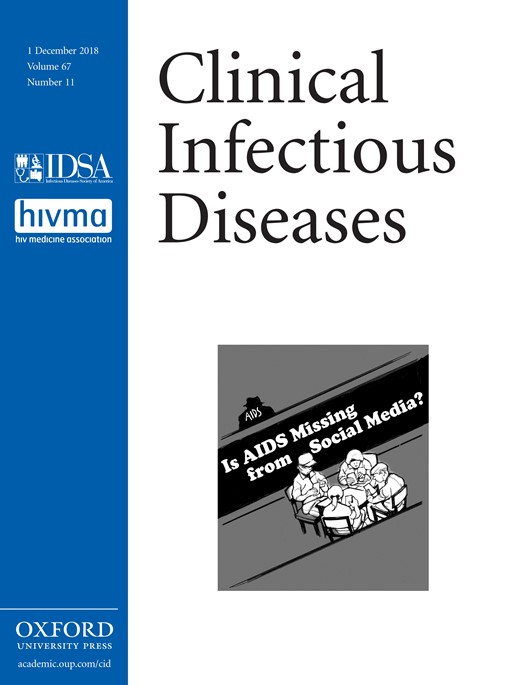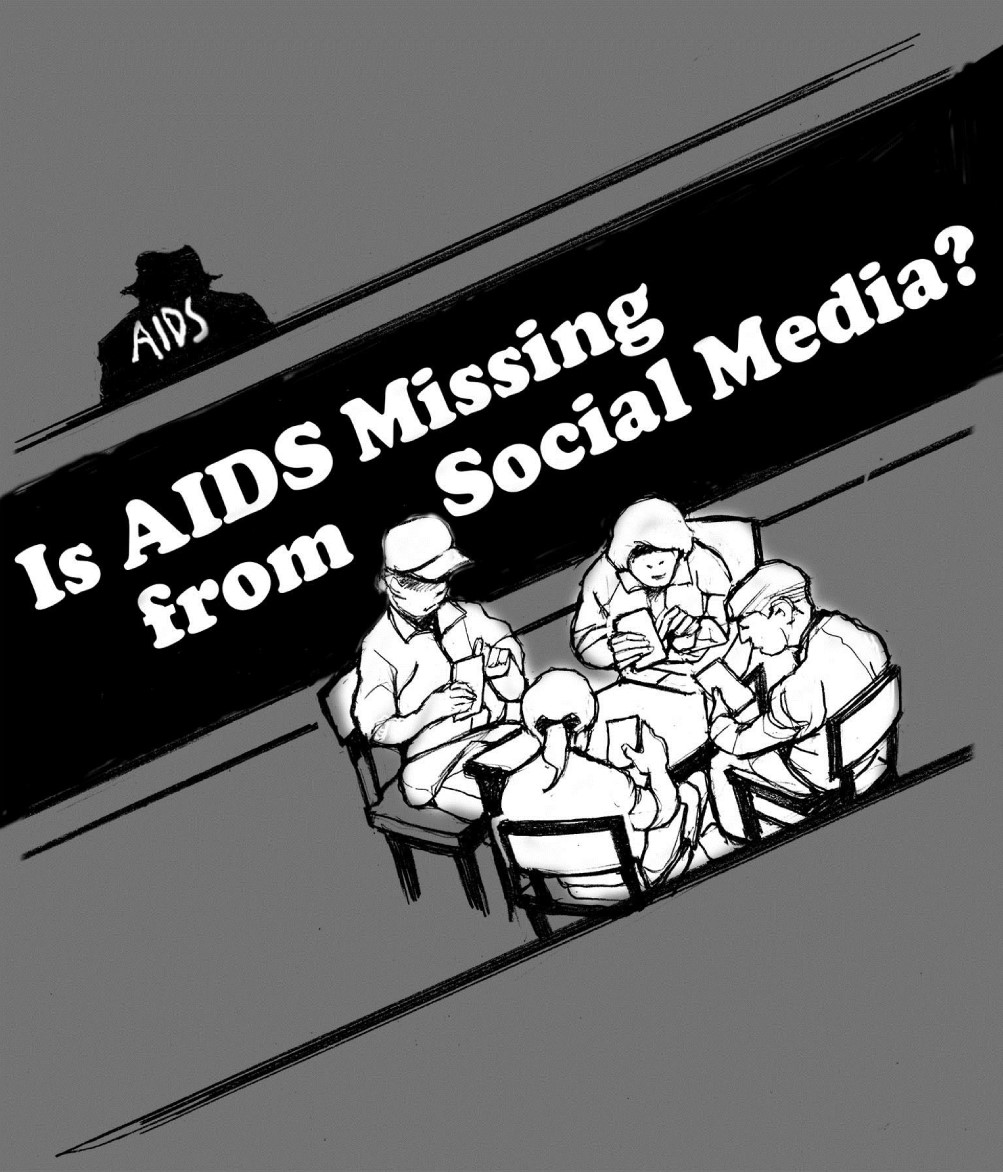
Cover image

Volume 67, Issue 11, 1 December 2018
NEWS
News
IN THE LITERATURE
In the Literature
ARTICLES AND COMMENTARIES
Outcomes of Patients Lost to Follow-up in African Antiretroviral Therapy Programs: Individual Patient Data Meta-analysis
Retention on antiretrovirals is of concern in Africa. We analyzed outcomes in patients lost to follow-up: at 4 years after last contact, 22% had died, 23% had stopped therapy, 15% were in another clinic, and 32% could not be found.
Transmission of Mycobacterium tuberculosis From Patients Who Are Nucleic Acid Amplification Test Negative
We assessed the transmission risk of pulmonary tuberculosis patients whose sputum nucleic acid amplification tests (NAAT) were negative. We estimated that, at minimum, sputum NAAT–negative tuberculosis patients had approximately a 5% risk of transmitting tuberculosis.
Epidemiology and Risk Factors for Cryptosporidiosis in Children From 8 Low-income Sites: Results From the MAL-ED Study
In this longitudinal multicenter study, 65% of children experienced Cryptosporidium infection during the first 2 years of life. Cryptosporidium was associated with severe diarrhea and dehydration and, in 2 South Asian sites, with stunted growth at age 2 years.
Large-scale Artemisinin–Piperaquine Mass Drug Administration With or Without Primaquine Dramatically Reduces Malaria in a Highly Endemic Region of Africa
Does adding low-dose primaquine to mass drug administration of artemisinin-based combination therapy improve malaria control? On a highly endemic African island, >99% effectiveness of falciparum malaria reduction followed 3 monthly rounds of artemisinin and piperaquine, with or without low-dose primaquine.
Benchmarking Inpatient Antimicrobial Use: A Comparison of Risk-Adjusted Observed-to-Expected Ratios
In this retrospective cohort of 2.7 million admissions, diagnosis-related groups, infection present on admission, unit, patient class, and history of methicillin-resistant Staphylococcus aureus/vancomycin-resistant Enterococcus were isolated as determinants of expected antimicrobial consumption in the most parsimonious model of observed-to-expected antibiotic use.
The Fog May be Lifting Around Antibiotic Use Metrics and Interfacility Comparison
Clinical Impact of a Multiplex Gastrointestinal Polymerase Chain Reaction Panel in Patients With Acute Gastroenteritis
A multiplex polymerase chain reaction panel facilitated the more rapid institution of appropriate antimicrobial therapy in patients with acute gastroenteritis compared to traditional diagnostic methods.
Longitudinal Trajectories of Brain Volume and Cortical Thickness in Treated and Untreated Primary Human Immunodeficiency Virus Infection
Longitudinal brain changes in treated and untreated individuals with primary HIV infection were examined. Before treatment, significant brain volume loss and cortical thinning were observed. After treatment, no further brain atrophy was found. This highlights the importance of early treatment.
Urine Antigen Detection as an Aid to Diagnose Invasive Aspergillosis
An immunodiagnostic assay that detects Aspergillus galactofuranose–containing antigens in urine was developed in dipstick format. Performance evaluated in a cohort of 78 subjects demonstrated good sensitivity and specificity relative to current diagnostic tests.
Safety and Immunogenicity of Zoster Vaccine Live in Human Immunodeficiency Virus–Infected Adults With CD4+ Cell Counts >200 Cells/mL Virologically Suppressed on Antiretroviral Therapy
Live attenuated herpes zoster vaccine administered to HIV-infected adults suppressed on antiretroviral therapy with CD4+ counts ≥200 cells/µL was generally safe and immunogenic. Antibody responses were similar to those observed in older adults without HIV infection who received the same vaccine.
Colonization With Levofloxacin-resistant Extended-spectrum β-Lactamase-producing Enterobacteriaceae and Risk of Bacteremia in Hematopoietic Stem Cell Transplant Recipients
Prior to transplant, 10% of hematopoietic stem cell transplant recipients were colonized with ESBL-producing Enterobacteriaceae (ESBL-E). In the setting of levofloxacin prophylaxis, 32% of colonized patients developed ESBL-E bacteremia during neutropenia and colonizing, and bloodstream ESBL-E were genetically identical.
Spectrum of Enterovirus Serotypes Causing Uncomplicated Hand, Foot, and Mouth Disease and Enteroviral Diagnostic Yield of Different Clinical Samples
Our study investigated the spectrum of enteroviruses causing uncomplicated hand, foot, and mouth disease, and compared epidemiology among EV-A71, CV-A16, CV-A6, CV-A10, and CV-A4. Enterovirus diagnostic yield of different clinical samples can guide optimal sample collection for virological diagnosis.
The Effect of Antibiotic Selection Pressure on the Nasopharyngeal Macrolide Resistome: A Cluster-randomized Trial
Communities randomized to annual mass azithromycin distributions for trachoma had a lower prevalence of genetic macrolide resistance determinants.
Intermediate Susceptibility Dose-Dependent Breakpoints For High-Dose Rifampin, Isoniazid, and Pyrazinamide Treatment in Multidrug-Resistant Tuberculosis Programs
Clinical susceptibility breakpoints for first-line antituberculosis drugs might be lower than previously thought, which means that more patients should receive second-line treatment. We propose an intermediate susceptibility dose-dependent category, which allows continued use of first-line drugs in higher doses.
Risk Factors and Incidence of Syphilis in Human Immunodeficiency Virus (HIV)–Infected Persons: The HIV Outpatient Study, 1999–2015
Syphilis incidence among persons with HIV increased from 0.4 to 2.2 per 100 person-years during 1999–2015 in a US cohort and reflects ongoing sexual risk and need for enhanced prevention interventions among HIV-infected patients in care.
Differences in Transmission and Disease Severity Between 2 Successive Waves of Chikungunya
Chikungunya was recently introduced into the Americas. Relatively little data exist about the introduction of chikungunya into naive populations. This study examines differences in transmission intensity and clinical severity between 2 epidemics of chikungunya in a single cohort in Nicaragua.
Multiple Class I and Class II Haemophilus ducreyi Strains Cause Cutaneous Ulcers in Children on an Endemic Island
Haemophilus ducreyi is a major cause of skin ulcers in the tropics. On an endemic island, multiple strains of H. ducreyi cause infection, coinfections are common, and mass treatment with azithromycin did not exert selection pressure on the organism.
PHOTO QUIZ
Two Birds, One Stone: Two Unusual Causes of Diarrhea in a Nonimmunocompromised Human Immunodeficiency Virus–Infected Patient
BRIEF REPORTS
Clinical and Cardiac Safety of Long-term Levofloxacin in Children Treated for Multidrug-resistant Tuberculosis
Detection and Isolation of Clostridium difficile Asymptomatic Carriers During Clostridium difficile Infection Outbreaks: An Exploratory Study
Risk Factors for Group A Streptococcus Colonization During an Outbreak Among People Experiencing Homelessness in Anchorage, Alaska, 2017
REVIEW ARTICLE
Hantavirus Cardiopulmonary Syndrome Due to Imported Andes Hantavirus Infection in Switzerland: A Multidisciplinary Challenge, Two Cases and a Literature Review
These 2 cases of Andes hantavirus infection imported to Switzerland illustrate the challenges for intensive care physicians facing severe hantavirus cardiopulmonary syndrome and for the infection control and laboratory teams that deal with an unfamiliar and potentially human-to-human transmissible pathogen.



